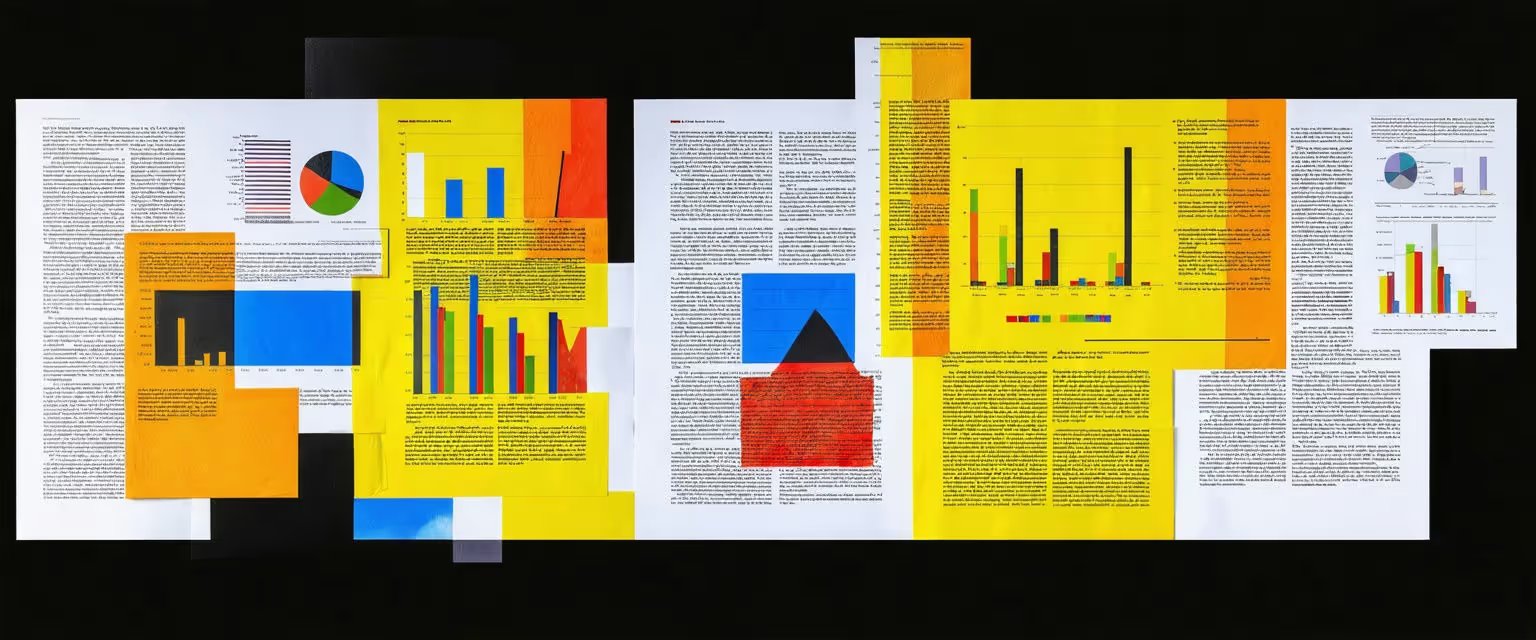All Posts
Construction - AI-Driven Software Integrations
How AI Automates Document Management in Construction

Discover how AI automates document management in construction, streamlining workflows, enhancing security, and optimizing resource allocation for better productivity.
Managing an overwhelming number of drawings, bid documents, and project requirements in construction often feels like navigating a maze. The constant battle to locate the right file, verify the latest version, or manually handle tasks not only wastes precious time but also leads to costly errors on-site. Inefficient document management and fragmented data systems are at the heart of these challenges.
Datagrid's data connectors provide a powerful solution by leveraging Agentic AI to streamline document handling across multiple platforms. By integrating Datagrid's technology, you can eliminate delays, reduce mistakes, and reclaim valuable hours in your workday.
Document Management Challenges
High Rate of Rework Due to Version Control Issues
Rework can pile up when critical documents—like plans or specs—get updated without clear version control. Pulling old drawings leads to expensive do-overs and extended schedules. A solid document control system keeps everyone on the same page, cutting errors before they spiral.
Wasted Labor Time from Slow Document Retrieval
Big projects come with massive paper trails: RFPs, change orders, inspection forms—you name it. When files sit in cluttered drives or binders, precious hours vanish just searching for the right data. Research suggests that web-based software can improve documentation processes by 43.9%. Better retrieval systems save that lost time so crews can get back to what they do best.
Impact of Siloed Data and Information
Multiple teams using multiple platforms can scatter data everywhere—one system for engineering, another for finance. Nobody has a clear view of the overall project status, leading to delayed decisions and missed updates. Centralized document management helps enhance data integration, consolidating information so every stakeholder works with the latest details. Implementing tools that allow document handling integration can bridge the gap between various platforms.
Communication Delays and Project Coordination Issues
Shuffling documents by hand or juggling email threads often leads to outdated information. Vital project details slip through the cracks, coordination stalls, and trust erodes. Robust document systems give everyone a single, up-to-date source. Real-time sharing of plan changes, daily logs, and new insights keeps tasks on schedule and teams in sync.
Security Leaks and Document Integrity
Handling sensitive information means security is paramount. When passwords get shared and random folders pile up on local drives, private documents can wind up in the wrong hands. Organizations need to lock down access and store data securely. Moreover, implementing secure PDF data handling practices ensures sensitive documents are processed and stored safely. Encryption, unique user credentials, and audit trails go a long way in safeguarding critical files.
How AI Automates Document Management
Construction documents can overwhelm even the most organized teams. AI automates document management in construction by tagging, categorizing, and storing files without constant manual oversight. By scanning drawings, permits, contracts, and even photocopied documents, machine learning algorithms clean up workflows and significantly reduce clerical errors.
Tools like AI agents for document review and AI data extraction streamline document processing. Apart from tagging and categorizing, AI can automate proposal validation, ensuring compliance and consistency across documents.
Automated retrieval means less time clicking through folders and more time getting the job done. Tools that automate PDF conversion further streamline the process, converting various document formats into easily accessible digital files.
NLP for Analyzing Project Requirements
Natural Language Processing (NLP) brings clarity to lengthy specs and contracts. AI parses text to uncover key details—like unique clauses, required materials, or critical deadlines—making it easier to ensure nothing slips past review. Project managers gain immediate insights that drive compliance and align teams with essential requirements. This precision adds an extra layer of protection against mistakes that could derail budgets or schedules.
Impact of AI on Streamlining Workflows
AI reshapes collaboration by centralizing information and keeping everyone plugged into the latest updates. Automated document management allows documents to flow to the right people at the right time, cutting extra meetings and back-and-forth emails.
Systems that automate document processing and automate proposal analysis help streamline workflows even further. Automated version control ensures each team works off the same set of plans, preventing rework. For more on how AI fosters real-time coordination.
Benefits of AI Integration for Construction Project Managers
Improved Time Management and Collaboration
Nothing slows momentum like double-checking schedules or sifting through outdated files. AI-powered settings free managers from repetitive tasks, so they can focus on strategy and problem-solving. Additionally, AI systems improve data accuracy by reducing human error in data entry and processing, which enhances decision-making quality. Scheduling software that uses machine learning accounts for labor pools, weather, and shifting deadlines, updating timelines on the fly. BIM systems then sync those changes across stakeholders to cut confusion and speed up approvals.
Cost Savings through Optimized Resource Allocation
By assessing large datasets, AI highlights inefficiencies and shows how to better distribute resources. Procurement, logistics, and budget forecasting become smoother when algorithms classify spending or flag high-impact cost drivers. AI also spots deviations from plans early, allowing corrective steps before waste—or spending—spirals out of control.
Enhanced Safety and Risk Management
AI-powered tools consistently scan project data for red flags, like potential safety hazards or compliance lapses. Drawing from patterns in historical incidents, these systems can forecast what might go wrong and provide actionable ways to prevent it. AI sensors track site conditions in real-time, further reducing accidents and setting a higher standard for on-site protection.
Facilitating Better Decision-Making
Data-driven insights let managers see emerging issues sooner. AI crunches both historical performance metrics and live project updates to guide decisions that optimize outcomes. This clarity helps pinpoint where to focus attention and budget, creating a streamlined environment for long-term growth.
User Considerations and Adoption Strategies
Common Pain Points and Approaches
The high-stakes nature of construction often leads firms to stick with familiar practices. Remote or intermittently connected sites can make large-scale AI deployments tricky. Costs for new software, devices, and training can also burden smaller operations. Plus, the industry faces a talent shortage, making it challenging to find AI specialists.
Actionable Insights for Integrating AI
- Pinpoint immediate needs—like safety tracking or schedule optimization—before rolling out solutions site-wide
- Start with small pilot phases to measure effectiveness before making bigger investments. Choose scalable AI solutions that can grow with your needs.
- Train your workforce on AI functions, encouraging collaboration between experts and field crews
- Keep data accurate, secure, and well-organized to strengthen AI interpretation
- Forge partnerships with experienced vendors who understand real-world site challenges and compliance concerns
Overcoming Barriers in AI Adoption
- Cultivate a mindset that views AI as a tool for better safety and coordination, not a threat to existing jobs
- Prioritize cybersecurity to keep sensitive project data and AI systems safe
- Share successful results with industry peers to standardize methods and spread best practices
- Demonstrate clear ROI metrics—such as reduced rework hours or lower supply costs—to justify continued AI investment
Competitive Advantage Opportunities with AI
Handling of Unstructured Data
A lot of construction information doesn't fit into neat columns—emails, text messages, design sketches all contain critical context that can slip through traditional systems. AI handles these loose data sources by converting them into machine-readable formats, known as embeddings.
With generative AI models, platforms can extract relevant specifics from varied document types, speeding up how teams search, store, and act on crucial project details.
AI's Role in Aligning Operational Strategies
AI sifts through massive data streams to spot patterns, fine-tune workflows, and keep construction goals in line with shifting realities. In vendor or subcontractor management, AI quickly pinpoints inefficiencies so that managers can course-correct early. Furthermore, AI proposal automation can streamline the processes of creating and managing proposals, ensuring consistency and saving time.
Compliance becomes less of a headache when regulations are summarized into direct steps, reporting significant improvements in some cases. This top-down alignment helps teams maintain strong performance without getting bogged down in red tape.
Adaptability of AI Systems
Business environments evolve, and AI evolves right along with them. That ongoing learning lets AI-driven document management tools stay relevant as new regulations, data formats, or stakeholder needs arise. Systems can also cater to specific sectors—healthcare, legal, manufacturing—by tailoring how data is processed and flagged. This flexibility keeps construction crews ready to pivot, no matter how fast project demands change.
How Agentic AI Simplifies Document Management
For construction project managers handling complex projects and seeking to streamline operations, Datagrid's data connectors and AI agents offer a transformative solution.
Datagrid's Agentic AI offers seamless integration with critical construction management systems, automating documentation workflows and daily tasks to free up valuable time for project oversight and client relationships.
Imagine connecting your core construction software like Procore, PlanGrid, or Autodesk BIM 360 with Datagrid's AI-powered platform. Suddenly, RFPs, submittals, change orders, and daily reports flow effortlessly between systems, eliminating manual data entry and reducing communication gaps.
AI agents can automatically process incoming bid documents, cross-reference specifications against historical data, and flag potential issues for project manager review. They can even track permit status updates and deadline requirements across multiple jurisdictions.
Datagrid's integration capabilities extend far beyond just construction-specific software. It connects seamlessly with popular project management tools like Microsoft Project and Primavera P6, allowing your team to access real-time schedule updates and resource allocation data without switching between applications. Financial systems like Sage 300 or QuickBooks can be linked, enabling automated cost tracking and budget forecasting.
The real power of Datagrid lies in its ability to automate complex, time-consuming tasks:
- Document management - AI agents can analyze incoming submittals, RFIs, and change orders, extract critical information, and route them to appropriate team members. This dramatically speeds up review cycles and keeps projects moving forward.
- Safety compliance - By connecting to safety management systems, the platform can automatically monitor incident reports, equipment certifications, and worker qualifications, triggering alerts for any compliance issues.
- Progress tracking - The platform can monitor daily reports, photos, and schedule updates across systems, generating automated progress reports and identifying potential delays before they impact the critical path.
- Communication - Integrations with platforms like Slack and Microsoft Teams ensure important updates, such as RFI responses or safety incidents, can be automatically routed to the right team members, ensuring swift action and collaboration.
By leveraging Datagrid's data connectors and AI agents, construction project managers can transform their operations. Routine documentation is handled automatically, data flows seamlessly between systems, and managers are empowered with AI-driven insights.
Simplify Construction Document Management with Agentic AI
Ready to revolutionize your construction project management with AI-powered automation? Datagrid is your solution for:
- Seamless integration across all major construction platforms (Procore, PlanGrid, BIM 360)
- AI-driven RFP analysis and bid management
- Automated submittal and change order processing
- Real-time project insights and schedule optimization
See how Datagrid can help you increase process efficiency.












